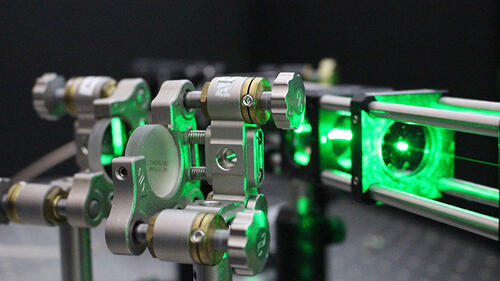
Two experiments with Wright Lab involvement, ALPHA and MAST-QG, have been chosen—along with nine other innovative “tabletop” experiments, out of hundreds of initial proposals—to be funded by a partnership of The Gordon and Betty Moore Foundation, the Simons Foundation, the Alfred P. Sloan Foundation, and the John Templeton Foundation. These small-scale experiments will explore realms of physics typically probed by large-scale facilities, including hunting for dark matter and examining the quantum nature of gravity.
ALPHA’s search for dark matter
The Axion Longitudinal Plasma Haloscope (ALPHA) collaboration seeks to build a new dark matter experiment with a powerful (16 Tesla) superconducting magnet that exists at Yale. The experiment will be located at Wright Lab and will search for a hypothetical dark matter candidate called the axion at a higher mass range than has been searched for previously.
The grant will enable the ALPHA team to advance dark matter research by pushing the boundaries of quantum detection and microwave technology. Leveraging their collective expertise across multiple domains, the researchers will build a next-generation haloscope outfitted with a powerful superconducting magnet, a novel metamaterial resonator, and a quantum sensing technique capable of detecting signals as low as a trillionth of a trillionth of a watt, known as squeezed-vacuum states.
Professor Steve Lamoreaux, who co-leads the ALPHA effort at Wright Lab along with professor Reina Maruyama, said, “Several factors, including our proven technical expertise with designing and operating axion haloscope detectors, identification of laboratory space at Wright Lab, and having an already existing suitable magnet–currently in professor Sean Barrett’s lab–resulted in Yale’s Wright Lab being chosen as the construction and operating site of the ALPHA detector.”
The ALPHA collaboration is led by Karl van Bibber of the University of California, Berkeley, and includes researchers from UC Berkeley, Yale, University of Colorado Boulder, MIT, Johns Hopkins, Wellesley, Arizona State University, Stockholm University, ITMO University, Cambridge and Oak Ridge National Laboratory.
MAST-QG: Is gravity quantum?
Wright Lab’s David Moore, associate professor in physics, is collaborating on a new experiment, “Macroscopic superpositions towards witnessing the quantum nature of gravity” (MAST-QG), led by Gavin Morley of the University of Warwick in England, that will test whether gravity has a quantum nature by levitating tiny diamonds in a vacuum.
According to Moore, no one has yet measured the gravitational field from a truly quantum object. If gravity is quantum, the diamonds are expected to become entangled through their gravitational interaction–that is, strongly linked in a way that is only possible in a quantum mechanical system.
There are still many challenges to realizing this idea, which the team will investigate during the project. The Moore group is using their expertise in precisely trapping nanoparticles and measuring electromagnetic interactions to create tabletop “traps” at Wright Lab to study the residual electromagnetic interactions between the nanodiamonds in the experiment. Moore said, “we need to eliminate all interactions between the nanoparticles other than gravity, which is incredibly challenging since gravity is so weak.”
The collaboration includes researchers from the University of Warwick, UCL, Yale, Northwestern, and Groningen in the Netherlands.
This article includes text adapted from the Simons Foundation press release of December 11, 2023; a UC Berkeley Engineering press release from December 15, 2023; and a SciTech Daily article from December 14, 2023.

